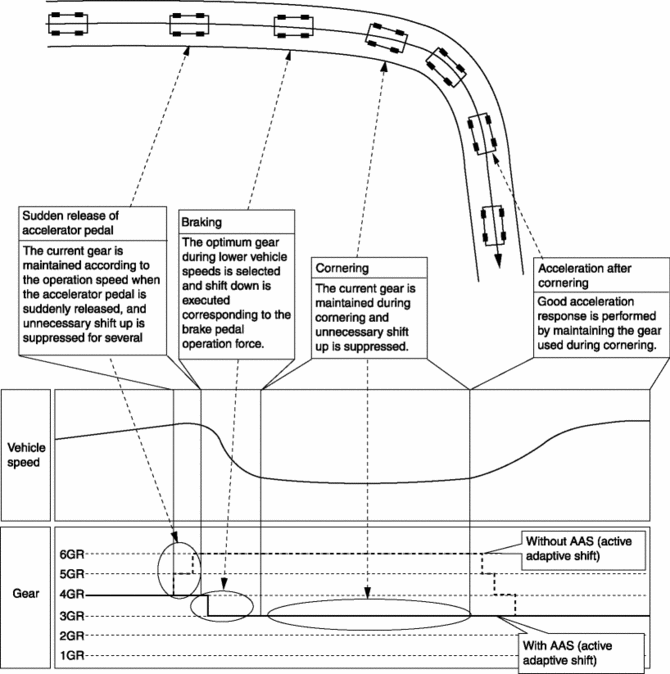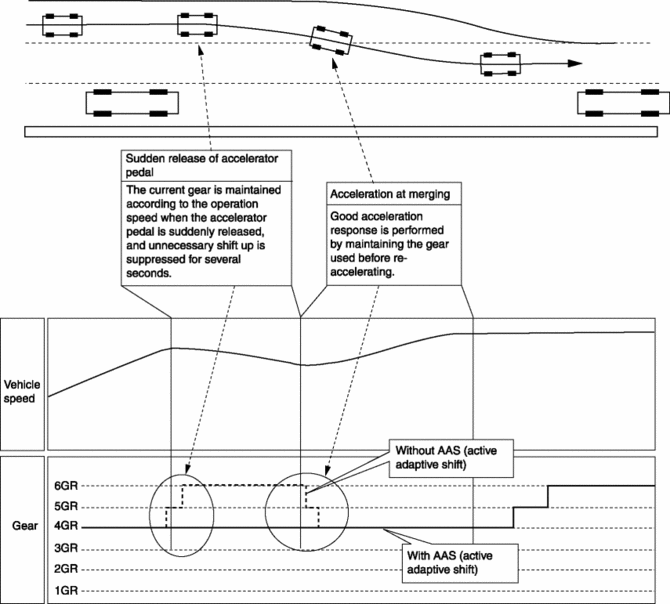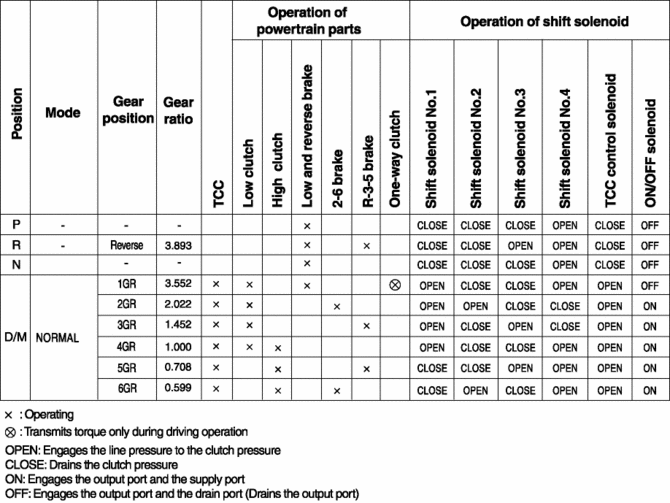Mazda CX-5 Service & Repair Manual: Shift Point Control (Automatic Shift Control) [Fw6 A EL, Fw6 Ax EL]
Outline
-
The TCM implements auto shift control according to the vehicle speed and accelerator pedal depression amount while in D position.
-
When the vehicle is stopped with the selector lever is in the D position and the brake pedal depressed, the neutral idle control is performed which internally controls the automatic transaxle to be in the neutral condition while the selector lever is in the D position. When the brake pedal is being released, the clutch is engaged immediately and the automatic transaxle returns to the normal D position condition. (Except for vehicles for Mexico)
-
When implementing the automatic shift control, the TCM determines the driving conditions based on each input signal and selects the drive mode appropriate to the driving conditions. In addition, information such as torque and gear changes is exchanged via PCM and CAN communication and control is performed so as to achieve optimum drive force according to the driving scenario.
Construction

Operation
Driving range determination
-
If a D position signal is input and an M position signal is not input, the TCM implements auto shift control.
Driving mode determination
-
For the auto shift control, NORMAL mode is usually selected, however it automatically switches to driving mode depending on the driving conditions.
-
AAS (Active Adaptive Shift) mode: Automatically controls the optimum shift point according to the road conditions and the driver operation.
-
High ATF temperature mode: When the ATF temperature rises to a high temperature, the engine torque is restricted so that the increase in ATF temperature is suppressed to protect the transaxle.
-
AAS (Active Adaptive Shift) mode operation
-
Accelerator pedal fully closed suddenly and returned
-
When the accelerator pedal is fully closed and returned at a certain speed or more, shift-up is inhibited for specified time to improve speed control and reacceleration performance.
-
Brake is strongly depressed
-
When decelerating at a certain speed or more, a lower gear is selected so that re-acceleration is performed smoothly.
-
During a shift change with the brake pedal depressed firmly, blipping control (synchronization to engine speed) is performed to shorten the shifting time.
-
When cornering
-
While cornering at a turn with a radius of less than a specified value, shift up is suppressed to improve vehicle speed performance while cornering and reacceleration performance after cornering.
-
During high degree of vehicle ascent/descent
-
During a certain level of vehicle ascent/descent, gears are selected appropriate to the driving conditions for driving comfort.
-
During ascent
-
While ascending a slope of a certain grade or more, slope mode control prevents unnecessary shift-up by maintaining the appropriate gear.
-
During descent
-
While descending a slope of a certain grade or more and depressing the brake pedal, the gears are appropriately shifted down according to the estimated slope angle for effective use of engine braking. As a result, frequent brake pedal operation is reduced.
-
AAS (active adaptive shift) operation scenario and effect
-
The AAS (active adaptive shift) is a mode which estimates the driving environment and drive’s intentions according to the vehicle driving conditions and the drive’s operations, and selects the optimum gear for driving.
-
During cornering, shift up is suppressed to improve acceleration performance after cornering.

-
In a scenario such as temporarily decelerating while merging onto a high speed expressway, shift up is suppressed directly afterwards to improve re-acceleration performance.

-
Ex.1: Cornering
-
Ex. 2) Merging onto high speed expressways
Automatic transaxle operation chart

 Shift Lever [C66 M R]
Shift Lever [C66 M R]
Purpose, Function
The shift lever operates the MTX via the control cable.
Construction
Shift lever
The shift lever is designed to prevent improper shifting to 1st gear and
...
 Shift Point Control (Manual Shift Control) [Fw6 A EL, Fw6 Ax EL]
Shift Point Control (Manual Shift Control) [Fw6 A EL, Fw6 Ax EL]
Outline
The TCM operates the manual shift control when the M position is selected.
If the M position is selected, manual shifting is prioritized according to
the driver’s shift up/ ...
Other materials:
Child-Restraint System Installation
Child-Restraint System Types
In this owner's manual, explanation of child-restraint systems is provided for
the following three types of popular childrestraint systems: infant seat, child
seat, booster seat.
NOTE
• Installation position is determined
by the type of child-restraint sys ...
Hydraulic Lash Adjuster, Rocker Arm
Purpose, Function
HLA
The HLA maintains the valve clearance at a constant 0 mm and maintenance-free
valve clearance is realized.
Rocker arm
With the adoption of the needle roller bearing built into the rocker arm,
the contact to the cam employs rolling contact to reduce sl ...
Liftgate Adjustment
1. Measure the gap and height difference between the liftgate and the body.
2. Loosen the liftgate hinge installation bolts and adjust the liftgate.
Standard clearance
a: 5.2?7.2 mm {0.21?0.28 in}
b: -2.0?0 mm {-0.078?0.000 in}
c: 3.8?6.2 mm {0.15?0.24 in}
d: ...
